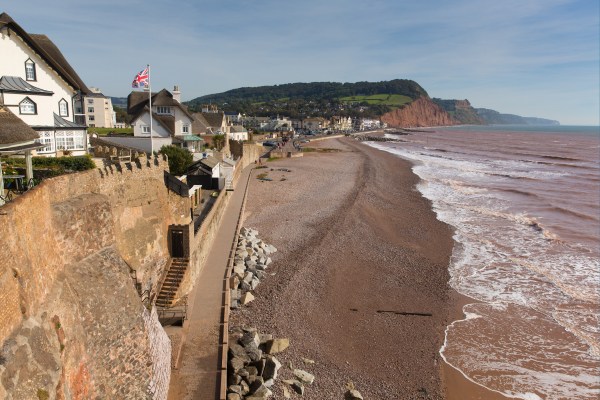
Introduction
In this series we take a look at key 2021 Census headlines in different areas. This time… East Devon. We found a District undergoing surprisingly rapid change.
Flying Geese consultants Beckie Smith and John Holmes met working at Exeter Northcott Theatre in the late 2000s. Back then – as now – East Devon residents made up a substantial part of the audience for Exeter’s cultural offering.
But what about arts and heritage specifically in East Devon? Beckie is currently delivering our Introduction to Marketing & Audience Development training for organisations based there. So as we’ve got to know the district all over again, we’ve put together this quick guide to what the latest Census data means for marketers there.
What do we mean by East Devon?
We’re specifically talking about the East Devon local government district, rather than the East Devon parliamentary constituency, which covers a smaller area.
East Devon covers a large area from the Exeter suburbs all the way to Dorset – almost a one hour drive. All 25 miles of East Devon’s coastline is part of the Jurassic Coast UNESCO World Heritage Site. Especially in the east, the district is very rural. There are no major towns, or one dominant settlement in the District. Instead the population is dispersed among rural areas and many smaller towns, including the seaside towns of Exmouth and Sidmouth, and Honiton, where the Council administration is based.
Population
Fast population growth means new audiences and challenges
East Devon is home to 150,800 people, equivalent to medium-sized cities such as Oxford or Canterbury. The most striking finding of all the Census data is how fast its population is growing.
East Devon’s population grew very quickly at a rate of 13.8% between 2011 and 2021 – the second fastest rate in the entire South West region. This means there are now 18,300 more people in East Devon than in 2011. The biggest reason for this is the development of new commuter towns and villages near Exeter. There is a brand new town – Cranbrook – which had no residents in 2011 but is now home to more than 6,000 people.
This presents opportunities and challenges for organisations in East Devon to take advantage of this population growth. The opportunity lies in the arrival of new potential audiences in all age groups (see below). The challenge is that the new developments have quick transport access to Exeter, with its larger arts and heritage attractions (e.g. it’s just 12 minutes on the train from Cranbrook). For these residents it’s more time consuming to reach other destinations in East Devon.
Age Profile
With the fast population growth comes an increase in children, working age adults and older people in East Devon. This is unusual for South West England, where many areas have seen a decrease in the number of children.
For example, when compared to 2011, there are now:
- 28% more children aged 5 to 9
- 41% more adults aged 30 to 35.
- 44% more adults aged 70 to 74
But despite this increase across different age groups, East Devon remains the area of South West England with the highest proportion of older people. Census 2021 shows that 30% of residents in the District are aged 65+.
Children
Because of the new developments such as Cranbrook, there are some quite radically disparities in age profiles across East Devon:
Areas with high percentages of people aged 15 and under are:
- Cranbrook 30%
- Broadclyst, West Clyst and Stoke Canon 19.8%
- Exmouth Withycombe Raleigh 18.6%
Areas with very small percentages of people 15 and under are all seaside towns:
- Sidmouth Town 8.7%
- Seaton 10.1%
- Budleigh Salterton 11.3%
Older people
The seaside towns also have very high percentages of people aged 65 and over:
- Sidmouth Town 50.9%
- Budleigh Salterton 44.6%
- Seaton 44.1%
In these areas challenges arising from social isolation are particularly acute. For example, in Sidmouth Town, nearly ⅓ of households (30.3%) are one-person households comprising a person over 65 living alone.
Surveys from the Audience Agency, Indigo and others have shown that older adults have been slower to return to live events since the pandemic than other age groups.
Younger people in seaside towns
It’s also important to recognise that because they are fewer in number, younger people living in the seaside towns might also experience isolation and a lack of opportunity compared to those in larger towns and cities.
Ethnicity, Language and Place of Birth
Despite the population growth, East Devon’s population remains among the most homogenous in the country across three measures – ethnicity, main language and place of birth.
Ethnicity
97.4% of people in East Devon identify as part of the ‘White’ ethnic group, compared to the national figure of 74.4%. This figure is consistent throughout the district.
Language
98.1% of East Devon residents speak English as their main language (national figure: 91.1%).
Place of birth
93.8% of East Devon’s population was born within the UK (national figure: 83.2%).
The most common countries of birth outside the UK were:
- Germany: 0.5% (approximately 750 people)
- Poland: 0.4% (approx. 600 people)
- South Africa: 0.4% (approx. 600 people)
These figures may be useful for benchmarking the diversity of your audience when reporting to funders.
Acknowledging Deprivation
East Devon has a complex picture relating to wealth and deprivation. 49.3% of East Devon households are deprived on at least one of the four Census dimensions – education, employment, health and housing. This is a similar figure to neighbouring areas such as South Somerset and Dorset.
However, there are significant variations within East Devon. In Honiton, North & East, 58.8% are deprived on at least one dimension. In Cranbrook, the figure is just 34.8%.
Public transport links are poor in East Devon. Despite this, some areas have a relatively high proportion of households without access to a car. This generally corresponds to higher levels of deprivation, for example Honition North & East, where the figure is 23.1%.
In Summary
Headline points from our analysis are:
- East Devon has a large number of new residents, especially in the new towns near Exeter. Organisations in East Devon need to move quickly to show these residents that what they offer is an alternative or complementary to what is going on in Exeter.
- The growth in children and working age adults means there is potential demand for activities geared at younger people, especially when compared to other areas of the South West. With so many new residents, arts, culture and heritage can help them get to know their new District.
- East Devon also has a very high proportion of older residents and older people living alone. Working with isolated older people is a key social challenge that arts and heritage can address.
- Despite the population growth, the diversity of East Devon in terms of ethnicity, language and place of birth has not changed significantly in the last decade.
- There is wealth and poverty in East Devon. Poor public transport links and lower levels of car ownership in some localities suggest a hyper-local approach, working in communities, will be beneficial.
